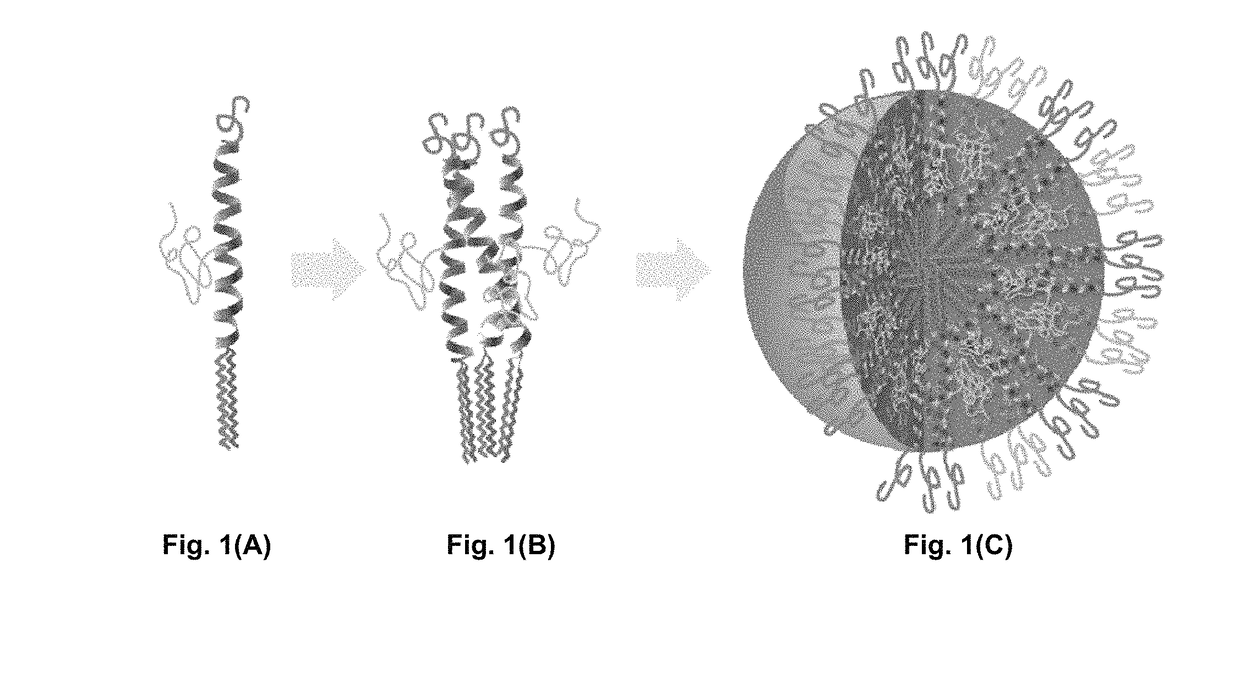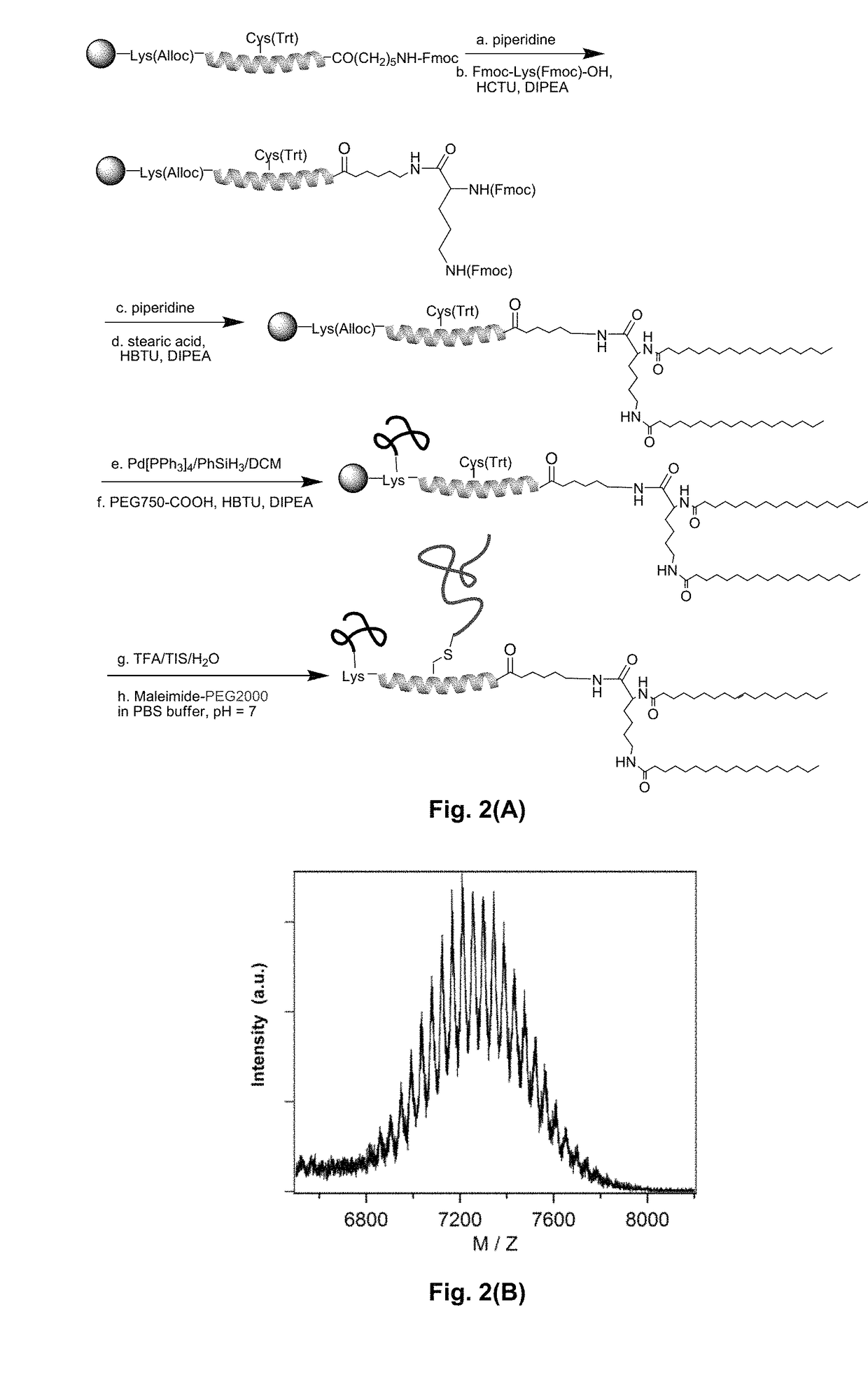Bis-polymer lipid-peptide conjugates and nanoparticles thereof
a technology of lipid-peptide conjugates and nanoparticles, which is applied in the direction of peptide/protein ingredients, radioactive preparation forms, macromolecular non-active ingredients, etc., can solve the problems of reducing the stability of micelles, insufficient elimination of malignant cells, and inefficient transport of chemotherapeutic drugs
- Summary
- Abstract
- Description
- Claims
- Application Information
AI Technical Summary
Benefits of technology
Problems solved by technology
Method used
Image
Examples
example 1
of Bis-Polymer Lipid-Peptide Conjugates
[0154]Materials. Fmoc-protected amino acids, 2-(1H-Benzotriazole-1-yl)-1,1,3,3-tetramethyluronium hexafluorophosphate (HBTU), 2-(6-Chloro-1H-benzotriazole-1-yl)-1,1,3,3-tetramethylaminium hexafluorophosphate (HCTU) were purchased from EMD biosciences and used without further purification. The side chain protecting groups of the Fmoc-protected amino acids were as follows: Lys(Boc), Glu(OtBu), Asp(OtBu), Cys(Trt), Arg(Pbf), His(Trt), Trp(Boc), Gln(Trt), Lys(Alloc). In addition, Fmoc-Lys(Fmoc)-OH was used for the conjugation of stearic acid to peptide, and a linker, Fmoc-6-Ahx-OH (Sigma Aldrich) was appended between the peptide and the alkyl tails. Peptide synthesis grade diethylpropylamine (DIPEA), trifluoroacetic acid (TFA), triisopropylsilane (TIS), diethyl ether, HPLC grade organic solvent dimethylformamide (DMF), dichloromethane (DCM), acetonitrile and isopropanol were purchased from Fisher and used without further purification. Piperidine, s...
example 2
ization and Loading of Bis-Polymer Lipid-Peptide Conjugate Micelles
[0164]Negatively Stained Transmission Electron Microscopy.
[0165]Lyophilized peptide powder was dissolved at 0.1 mg / ml in 25 mM phosphate buffer at pH 7.4. 5 μl of peptide solution was dropped on a discharged holey carbon coated grid (Ted Pella 01824). After removing excess peptide solution, 5 μl of phosphotungstic acid (2 wt %, pH=3.3) solution was then applied for 2 minutes. Samples were dried in air and examined using a FEI Tecnai 12 transmission electron microscope at 120 kV.
[0166]Dynamic Light Scattering (DLS).
[0167]DLS size measurements were taken on a Malvern Zetasizer Nano-ZS with a 633 nm laser and a scattering angle of 17° to determine the hydrodynamic radius of samples in solution. Samples were passed through 0.22 μm filters prior to the measurements.
[0168]Size Exclusion Chromatography (SEC).
[0169]SEC was carried out on a BioSep-SEC-S 4000 column (Phenomenex). The flow rate was 1 ml / min with 25 mM phosphate...
example 3
haracterization of Bis-Polymer Lipid-Peptide Conjugate Micelles
Synthesis of 6-p-(4-(N-maleimidomethyl)cyclohexan-1-amido)benzyl 1,4,8,11-tetraazacyclotetradecane-N,N′,N″,N′″ tetraacetate (6-BAT-maleimide)
[0194]6-p-aminobenzyl 1,4,8,11-tetraazacyclotetradecane-N,N′,N″,N′″ tetraacetate (6-Aminobenzyl TETA, 25 mg) was reacted with sulfo-SMCC (25 mg, ProteoChem, Denver) in phosphate buffered saline (PBS 1×, 8 mL) and the pH was maintained at 7 for 2 hours with the addition of 1 M sodium hydroxide solution. The reaction mixture was diluted with 0.1% TFA solution (4 mL). 6-BAT maleimide was isolated with a reverse phase HPLC system (Jupiter Proteo C12, 250×10 mm) and elution was monitored at 220 and 254 nm wavelengths. The flow rate was 3 mL / min and a linear gradient was applied as 5 to 60% solvent B over 30 min (solvent A: 0.1% TFA DI water (v / v), solvent B: 0.1% TFA acetonitrile (v / v)).
Synthesis of 6-BAT-dC18-1coi(PEG2K)-PEG750
[0195]To introduce PEG2K, Fmoc-Lys(Alloc)-OH was used at the...
PUM
| Property | Measurement | Unit |
|---|---|---|
| molecular weight | aaaaa | aaaaa |
| molecular weight | aaaaa | aaaaa |
| molecular weight | aaaaa | aaaaa |
Abstract
Description
Claims
Application Information
 Login to View More
Login to View More - R&D
- Intellectual Property
- Life Sciences
- Materials
- Tech Scout
- Unparalleled Data Quality
- Higher Quality Content
- 60% Fewer Hallucinations
Browse by: Latest US Patents, China's latest patents, Technical Efficacy Thesaurus, Application Domain, Technology Topic, Popular Technical Reports.
© 2025 PatSnap. All rights reserved.Legal|Privacy policy|Modern Slavery Act Transparency Statement|Sitemap|About US| Contact US: help@patsnap.com



